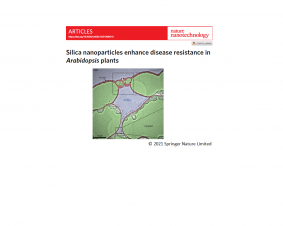 >
Spotlight July 2022: New definition on nanomaterials published
>
Spotlight July 2022: New definition on nanomaterials published
The European Union has published a new definition for nanomaterials as of June 2022. It is recommended that this be used as a basis for future legislation. The new documents can be found on the EC website.
In the new “nanodefinition”, the essential components such as the origin or the size range of the particles (1-100 nm) remain mostly unchanged, but some aspects are simplified that were only included in the old definition from 2011 through explicit extensions. For example, nanomaterials with dimensions below one nanometre, such as some nanotubes and graphene, which were previously explicitly included, are now included generically. For this purpose, elongated particles with two external dimensions smaller than 1 nm and one dimension larger than 100 nm as well as platelet-like particles with one dimension smaller than 1 nm and two dimensions larger than 100 nm are newly taken into account. Particles with two orthogonal external dimensions larger than 100 µm no longer have to be taken into account.
Likewise, some decision criteria have been clarified and simplified. The previous criterion that a material with a volume specific surface area (VSSA) of 60 m2/cm3 or more was classified as nano has now been dropped. Conversely, in future a material can be designated as non-nano if the VSSA is smaller than 6 m2/cm3. Finally, the threshold for the particle number-based size distribution in the new definition is no longer flexible, but fixed at 50 %.

Weitere Spotlights
Spotlight September 2021: Wood, the raw material of the future?
One of the greatest challenges facing humanity is to produce clean drinking water under the given circumstances of global warming, population growth and increasing littering. In September, we would like to present a review article that believes one approach to solve this problem is the use of nanoscale wood. In the review, “Advanced Nanowood Materials […]
Read moreSpotlight June 2021: Endotoxin – the reason for false-positive toxicity testing for advanced materials?
Advanced materials, but also nanomaterials are closely examined to determine whether they trigger biological effects that could be harmful to humans and the environment before they are used in products. This also includes such materials as titanium dioxide, which has been used in a wide variety of products for more than 50 years. A particularly […]
Read moreSpotlight December 2021: Silica nanoparticles improve plant disease resistance
The resistance of plants to various pathogens is often increased in agriculture with various chemicals (“fertilizers”). A new direction is being taken with the use of nanoparticles. These can be sprayed on the plants. In the present study, the model plant Arabidopsis was used to investigate whether silicon dioxide nanoparticles (SiO2) can increase resistance to […]
Read moreSpotlight August 2021: Towards FAIR nanosafety data
In August we would like to present a paper on FAIR data. The paper published in Nature Nanotechnology in June 2021 summarises the challenges and provides recommendations for the efficient reuse of nanosafety data in line with the recently established FAIR guiding principles: findable, accessible, interoperable and reusable. This article summarises the know-how on the […]
Read more


